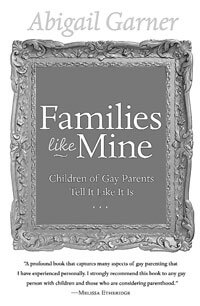How-to guide succeeds when calling queer theorists to action
Garner certainly has something to say on the topic; she is a child of gay parents and an experienced advocate for the gay and lesbian community. Yet, she can’t decide with whom she wants to share her knowledge – lesbian, gay, bisexual and transgender families (LGBT), or those who discriminate against them.
In trying to write for both audiences, Garner’s strategy reveals its weaknesses early on. In chapter two, “Coming Out: A Family Process,” Garner offers a manual for LGBT parents who want to come out to their kids. Strangely, this how-to advice is sprinkled with banal descriptions of heterosexism that are best suited for straight people with no clue: “A quick kiss in public between two moms or two dads can warrant awkwardness and furrowed brows from homophobic onlookers.” (Actually, even straight people with no clue know this.)
“Families” continues with this bizarre recipe—two parts insightful advice for LGBT families mixed with one part “gays are people too” for homophobes. The absence of an intended audience gives the book a split personality that is at least distracting and at most irresponsible.
“Families” also switches back and forth between memoir and sociological study. Throughout the text, Garner includes both her personal stories and her interviews with other “queerspawn.” While Garner’s personal narrative is easily the most meaningful ingredient in the mix, it reveals a bias that may have tainted her fieldwork. Too bad she does not fully explain her methods for interviewing nor account for her partiality.
Garner would have been much better off writing a memoir instead of a combo-pack advice column, activist pamphlet, sociology thesis, and feminist critique.
Garner’s feminist critique is wholly worthwhile. At the start of chapter five, “Family-Defining Moments: Respecting Queer Families, from Grandma’s House to the White House,” Garner adapts academic theories of white privilege to conceptualize and brilliantly discuss heterosexual-family privilege. This short, but powerful section, proves that Garner should include more aspects from feminist, race, and queer theories in her work.
Fortunately, Garner utilizes feminist perspectives of language to reveal the paucity of words available to describe LGBT families: “As language is often dictated by the culture in power, heterosexism limits the words we have to describe queer relationships.” “LGBT families often lack appropriate nouns, which results in the need for something close to a short paragraph to explain our relationship with each family member.” Garner concludes this theoretical section with a stirring activist statement: “We need a verbal revolution.”
Although Garner’s mixed-media approach often fails, she is able to effectively combine feminist theory with her activism and personal experience in Chapter 8, “Tourists at Home: Straight Kids in Queer Culture.” Several of this chapter’s subsections, including “Passing: When Straight Kids Are Presumed To Be LGBT” and “Straight Shame,” are truly groundbreaking. She offers unique perspectives of straight children raised by LGBT parents and discovers new and valuable areas of inquiry for feminist and queer theorists. For example, she re-contextualizes the coming-out process when she claims that many straight children feel they must come out to their LGBT parents: “When heterosexual children become aware of their sexual orientation, some make a point to officially ‘come out’ to their parents in a way that parallels a person coming out as gay.” Queer theorists: have at it.
Garner completes her book by expanding upon this controversial notion and calling for the inclusion of straight children in the LGBT community: “Facing adulthood and ‘coming out’ as heterosexual does not mean children should have to relinquish ties to the LGBT community – the very community that has loved and nurtured them. If straight children have permission to maintain their sense of belonging, they can proudly carry the gifts of their queer heritage with them into adulthood.” Here, Garner herself is asking to be included in the LGBT community. Though she identifies as “culturally queer,” her book presents several examples in which her heterosexuality resulted in dismissal from the community.
But Garner finds her voice after most readers are snoozing in their easy chairs, glasses in lap, book on floor. If you decide to pick up a copy, start about a hundred pages in, which is where “Families Like Mine” finally hits its stride.



































